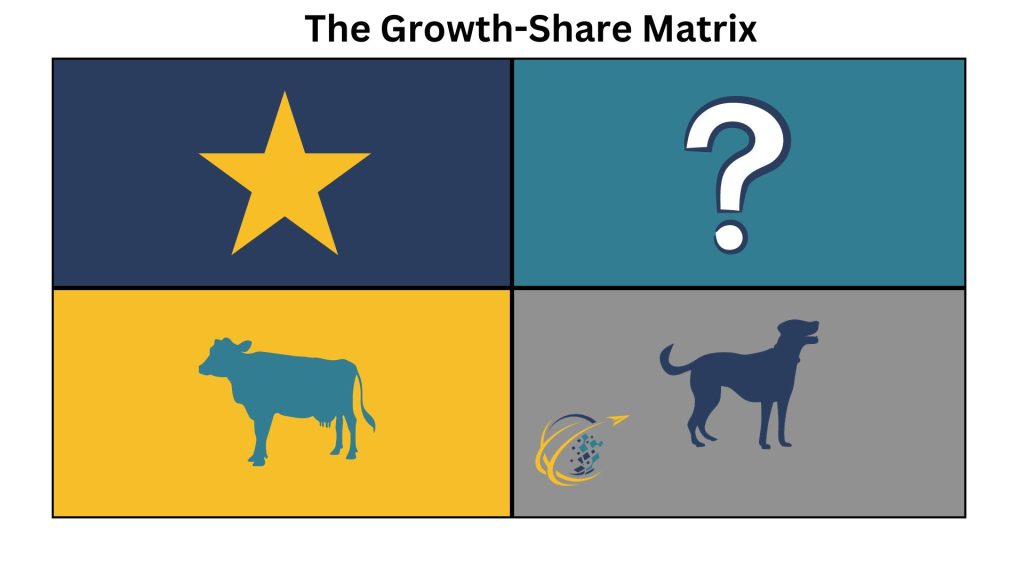
The main idea behind the Growth-Share Matrix is that companies should invest in products with high potential returns and reduce investments in resource-draining products. By understanding the link between market share and growth, businesses can make investments that maximize profitability and long-term success. This model helps companies make decisions on resource allocation and provides a framework to evaluate the health of their product portfolios.
The Four Quadrants of the Growth-Share Matrix
The Growth-Share Matrix divides products or business units into four distinct categories based on their position in the matrix. The first category is “Stars,” which represents products with high market growth and a dominant market share. Stars require significant investment to maintain or increase their market dominance, but they also offer the potential for substantial returns. As market growth slows, Stars have the potential to transition into Cash Cows.
Cash Cows represent products with a high market share in a low-growth market. These products generate consistent revenue with minimal investment, making them critical for funding other areas of the business. Cash Cows are often the backbone of a company’s profitability, providing the financial stability needed to support riskier ventures.
Question Marks, or Problem Children, are products in high-growth markets but with low market share. These products require careful evaluation. This is because they have the potential to become Stars with the right investment or to drain resources without delivering adequate returns. Companies must decide whether to invest heavily in Question Marks to grow their market share or to divest and focus on more promising opportunities.
Finally, Dogs are products with low market share in low-growth markets. These products typically offer little to no profit and often consume more resources than they generate. In most cases, companies should consider divesting from or discontinuing these products to reallocate resources to more lucrative ventures.
Strategic Implications of the Growth-Share Matrix
The Growth-Share Matrix offers several strategic insights for businesses looking to optimize their product portfolios. First, the matrix emphasizes the importance of balance. A healthy portfolio typically includes a mix of Stars, Cash Cows, and Question Marks. This ensures both short-term profitability and long-term growth potential. Relying too heavily on one quadrant can expose a company to unnecessary risks. For example, a portfolio dominated by Cash Cows may generate steady profits. However, the lack of growth could leave the company vulnerable to future market shifts.
Additionally, the matrix underscores the importance of investment decisions. Stars require heavy investment to maintain their market position, but they also promise high returns as the market grows. In contrast, companies should approach Question Marks with caution, as not all products in this category will evolve into Stars. Strategic analysis is essential in deciding where to allocate resources. This ensures that investments yield the best possible outcomes for the company.
The matrix also helps companies identify products that are no longer contributing to the business’s growth or profitability. By highlighting Dogs, the Growth-Share Matrix encourages companies to make tough decisions about which products to discontinue. While it can be challenging to divest from a product, especially if it has been part of the company’s portfolio for a long time, the long-term benefits often outweigh the costs.
The Role of the Growth-Share Matrix in Modern Business
Although the Growth-Share Matrix was developed over five decades ago, it remains highly relevant in today’s fast-paced and ever-evolving business landscape. As businesses face increasing competition and rapid technological changes, they must continually reassess their product portfolios to remain competitive. The matrix provides a straightforward framework for doing so. It helps companies make informed decisions about which products to grow, maintain, or discontinue.
Moreover, in an era of limited resources, businesses must be strategic about how they allocate their investments. The Growth-Share Matrix offers a clear and concise method for evaluating the potential returns on investment for each product, ensuring that resources are directed toward the most promising opportunities. In this way, the matrix not only helps companies manage their current portfolio but also guides future product development and market entry decisions.
Another reason the matrix continues to be relevant is its simplicity. In a world where business analysis can often be complex and data-heavy, the Growth-Share Matrix offers a clear and intuitive way for managers to visualize their product portfolio’s performance. This simplicity makes it a valuable tool for both seasoned executives and emerging managers.
Challenges and Limitations
While the Growth-Share Matrix offers numerous benefits, it also comes with certain limitations. One of the primary challenges is its reliance on two factors—market growth and market share. While these factors provide valuable insights, they do not capture the full complexity of a product’s performance or potential. Other factors, such as competitive landscape, customer loyalty, or technological innovation, may also play a crucial role in determining a product’s success.
Additionally, the matrix assumes that market share leads to profitability, which may not always be the case. In some industries, maintaining a high market share can be costly, and the expected returns may not materialize. Furthermore, the matrix’s emphasis on market growth may overlook other important factors, such as sustainability or long-term market trends.
Despite these limitations, the Growth-Share Matrix remains a useful tool for guiding strategic decision-making. Companies should view the matrix as one part of a broader strategy framework, using it in conjunction with other analytical tools to develop a comprehensive understanding of their product portfolio’s strengths and weaknesses.
In conclusion, the Growth-Share Matrix continues to be a valuable tool for businesses seeking to optimize their product portfolios. By categorizing products into Stars, Cash Cows, Question Marks, and Dogs, companies can make informed decisions about resource allocation, investment, and divestment. The matrix provides a simple yet effective way to assess the potential of each product, ensuring that businesses focus on opportunities that offer the greatest returns. As markets evolve and competition intensifies, the Growth-Share Matrix remains a critical component of strategic planning and portfolio management.

